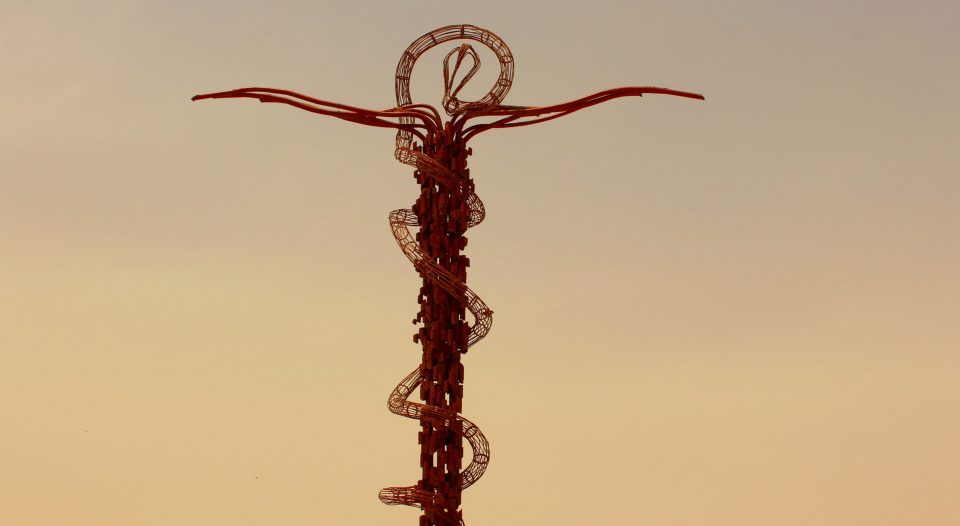Lectionary for March 14, 2021
Fourth Sunday in Lent
Numbers 21:4-9; Psalm 107:1-3, 17-22;
Ephesians 2:1-10; John 3:14-21
This week’s passage from John uses a fairly obscure story from Israel’s wandering in the wilderness to illustrate Jesus’ mission on earth. The text says that just as the bronze serpent was lifted up in the desert, so will the Son of Man be lifted up. Jesus indicated that he would be lifted on a pole, and there he would provide salvation. If we stop thinking about Jesus comparing himself to the bronze serpent in verse 14 and simply move on to John 3:16, then we short-change the power of what he was saying.
In the wilderness narratives, when the Israelites complained—understandably—that they were without water and—ungratefully—that they were tired of manna, God sent fiery serpents among the people and many died (Numbers 21). The translation of “poisonous serpents” in the New Revised Standard Version is somewhat lacking, I think. These were literally “the seraphim snakes” (haNechashim haSeraphim) (21:6). Picture not just fatally poisonous serpents (as if that weren’t frightening enough), but giant flaming serpents—bigger than humans with multiple sets of wings—that were accustomed to serving in the heavenly court in the presence of God. These heavenly monsters didn’t just bite, they flew and were on fire.
When Moses, on behalf of the people, asked God to take away this utter nightmare, God did something strange—God had Moses cast a bronze serpent. The fiery flying serpents didn’t stop terrorizing the people. But when the people were bitten, they could look at the bronze serpent and be healed. The terror wasn’t completely taken away, but the people were given a way in which they could be saved by looking upon the one who was lifted up.
Jesus brought up the story of the fiery serpents to Nicodemus as a series of three object lessons. His first point was about beings that came from heaven—not the normal earthly variety of things. Jesus said: “Very truly, I tell you, we speak of what we know and testify to what we have seen; yet you do not receive our testimony. If I have told you about earthly things and you do not believe, how can you believe if I tell you about heavenly things? No one has ascended into heaven except the one who descended from heaven, the Son of Man” (John 3:11-13).
It’s important to notice, then, that Jesus doesn’t reference just any snakes that God called together. To make the point about where he comes from, it wouldn’t suffice to compare himself to a normal animal. Rather, Jesus pointed to his common home with the fiery serpents that were sent down from the throne room of heaven.
God sent the serpents to condemn complainers to death, and then the bronze serpent was constructed to save them. Jesus only came to save, not to condemn.
Second, we need to remember that Moses’ bronze serpent doesn’t only appear in the book of Numbers. During the time of King Hezekiah’s reforms, the bronze serpent played a somewhat important role. 2 Kings 18:4 summarizes Hezekiah’s reign, saying he smashed the sacred pillars, cut down the asherah poles and cut into pieces the bronze serpent that Moses had made. The bronze serpent, originally meant as a healing gift, had become an idol when the people started to worship the Nehushtan (bronze thing) instead of God who sent it for their salvation.
Years after his temple reforms and after the destruction of the Northern Kingdom of Israel, the Assyrians campaigned in the Southern Kingdom of Judah. When Sennacharib’s Assyrian army laid siege against Jerusalem, Hezekiah paid a tribute that included precious metals from the temple (2 Kings 18:14-16). Sennacharib’s records of the ransom state that considerable bronze and other metals were also involved in the payment. In the excavations of ancient Assyrian Nimrod/Caleh, archeologists found broken bronze pieces that included the inscription “for the LORD” in Hebrew and images of flying serpents. This suggests that when Hezekiah was doing his reforms, he used the broken bits of the Nehushtan to pay ransom to the Assyrian king on behalf of the people so they wouldn’t be killed or taken into slavery.
Nicodemus and everyone else living under Roman occupation in Jerusalem would have had at the front of their minds the ways in which God, working through previous kings, had repeatedly spared the people from captivity and saved them from oppression. That Hezekiah probably used the broken bits of the bronze serpent to save the people from wrath was not only incredibly shrewd but also prefigures how Jesus would be broken and given over to an evil empire. The Son of Man was crushed and descended into the realm of the dead so he could free captives from the powers of sin and death.
Notwithstanding their similarity, Jesus is careful, however, to mark a strong distinction between himself and the fiery serpents/bronze serpent. God sent the serpents to condemn complainers to death, and then the bronze serpent was constructed to save them. Jesus only came to save, not to condemn. “Indeed, God did not send the Son into the world to condemn the world, but in order that the world might be saved through him. Those who believe in him are not condemned …” (John 3:17-18a).
Jesus used the image of the Nehushtan to explain to Nicodemus that he was sent directly from heaven and wasn’t just another prophet, that he would be broken and given over to the empire as a ransom for the people, and that his death would involve being lifted on a stake. Lest Nicodemus have the wrong idea, though, Jesus quickly described himself as coming at the behest of God’s love, and that he didn’t come to condemn but to save. In this, Jesus is like a fiery serpent, but also quite different.





